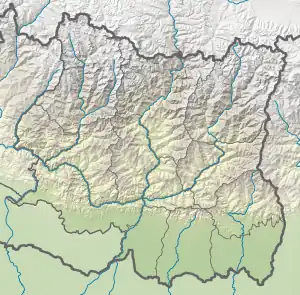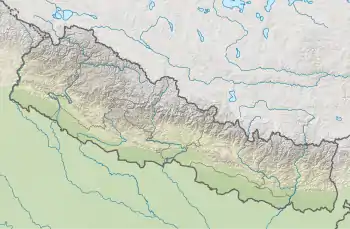Phakphokthum Rural Municipality
Phakphokthum (Nepali: फाकफोकथुम) is a rural municipality (Nepali: गाउँपालिका; gaunpalika), one of six located in Ilam District of Koshi Province of Nepal. A total of 10 municipalities are found in Ilam, of which 4 are urban and 6 are rural.
Phakphokthum
फाकफोकथुम गाउँपालिका | |
|---|---|
 Phakphokthum Location in Province No. 1  Phakphokthum Phakphokthum (Nepal) | |
| Coordinates: 26°59′5.81″N 87°43′10.2″E | |
| Province | Koshi Province |
| District | Ilam |
| Wards | 7 |
| Established | 10 March 2017 |
| Seat | Phakphok |
| Government | |
| • Type | Village Council |
| • Chairperson | Mr. Ram Shrestha (NC) |
| • Vice-chairperson | Mrs. Saraswati Rai (NCP) |
| Area | |
| • Total | 108.79 km2 (42.00 sq mi) |
| Population (2011) | |
| • Total | 21,619 |
| • Density | 200/km2 (510/sq mi) |
| Time zone | UTC+5:45 (Nepal Standard Time) |
| Area code | 027 |
| Website | official website |
According to Ministry of Federal Affairs and Local Development, Phakphokthum has an area of 108.79 square kilometres (42.00 sq mi) and the population of the municipality is 21,619 as of the 2011 Nepal census.[1][2]
It has 7 wards. Phakphok is the municipal headquarters.
History
Phakphokthum was a village development committee named Phakphok located in the Mechi Zone. Fulfilling the requirement of the new Constitution of Nepal 2015, Ministry of Federal Affairs and Local Development converted all VDCs and Municipalities into 753 new local level bodies. Phakphok turned into a rural municipality as Phakphokthum and the adjoining village development committees added to this. The adjoining VDCs added to this were: Amchok, Phuyatappa, Lumde, Ektappa and Chamaita.[1]
Economy
The major occupation of the people in this rural municipality is agriculture.
Governance
Phakphokthum lies in constituency number 2 of Ilam district. Subash Nemwang was elected as a member of parliament in the election of 2017. This is one of the most remote villages of the District.
Transport
The Damak-Rabi Phagunanda road connects the municipality through shortest way with the southern plains. The span of the highway is about 45 km.
Demographics
At the time of the 2011 Nepal census Phakphokthum Rural Municipality had a population of 21,619. Of these, 40.3% spoke Nepali, 20.7% Limbu, 11.5% Rai, 11.4% Magar, 5.4% Bantawa, 3.7% Tamang, 2.8% Newar, 1.4% Sunwar, 0.6% Gurung, 0.2% Bhujel, 0.2% Chamling, 0.2% Sampang, 0.1% Hindi, 0.1% Kulung, 0.1% Maithili, 0.1% Sherpa and 1.0% other languages as their first language.[3]
In terms of ethnicity/caste, 21.0% were Limbu, 19.6% Chhetri, 18.4% Rai, 11.8% Magar, 11.7% Hill Brahmin, 3.8% Kami, 3.8% Tamang, 3.2% Newar, 1.6% Damai/Dholi, 1.5% Sunuwar, 1.0% Sanyasi/Dasnami, 0.8% Gharti/Bhujel, 0.7% Gurung, 0.4% Sarki, 0.1% Bote, 0.1% Terai Brahmin, 0.1% Sherpa and 0.5% others.[4]
In terms of religion, 47.0% Hindu, 38.1% Kirati, 14.0% Buddhist, 0.5% Christian, 0.1% Prakriti and 0.2% others.[5]
In terms of literacy, 75.4% could read and write, 2.7% could only read and 21.8% could neither read nor write.[6]
See also
External links
References
- "स्थानीय तहहरुको विवरण". www.mofald.gov.np/en. MoFALD. Archived from the original on 31 August 2018. Retrieved 13 April 2018.
- "CITY POPULATION – statistics, maps & charts". www.citypopulation.de. 8 October 2017. Retrieved 13 April 2018.
- NepalMap Language
- NepalMap Caste
- NepalMap Religion
- NepalMap Literacy
